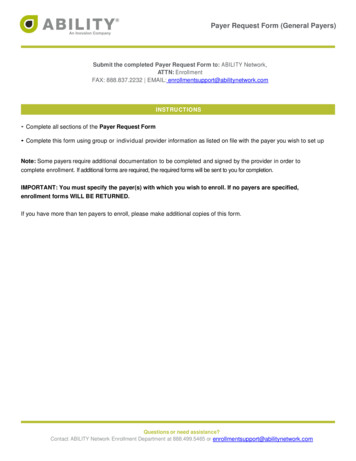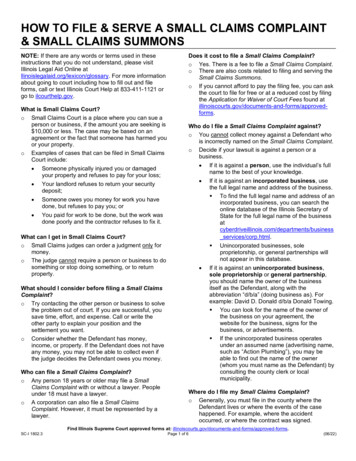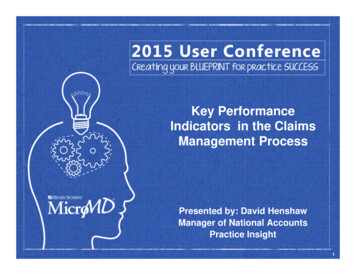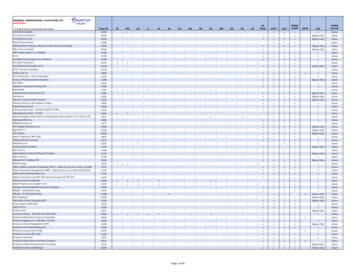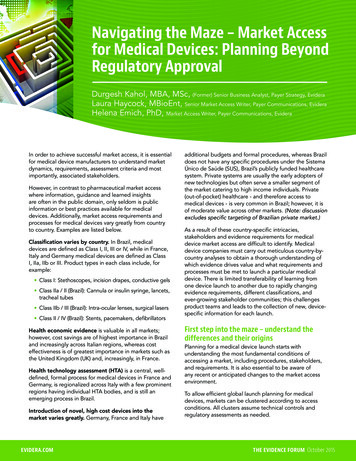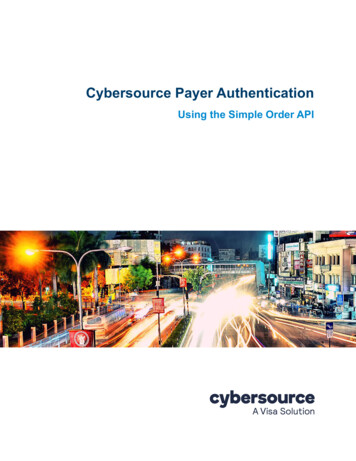
Transcription
THDeveloped with the support ofAll-PayerClaims DatabaseDEVELOPMENT MANUALEstablishing a Foundation for Health CareTransparency and Informed Decision MakingMAR 2015APCDCOUNCILAll-PayerClaims DatabaseSMThe APCD Council is convened and coordinated by the Institute for Health Policy and Practiceat the University of New Hampshire and the National Association of Health Data Organizations.
SMAcknowledgementThis APCD Manual was created by the APCD Council with assistance andsupport from the Gary and Mary West Health Policy Center.About the West Health Policy CenterThe Gary and Mary West Health Policy Center is a nonprofit, non-partisanresource in Washington, D.C. providing education, expertise and policyproposals to transform the American healthcare experience. We’re wholly fundedby philanthropists Gary and Mary West as part of West Health, four organizationswith a common mission—pioneering new and smarter technologies, policies andpractices, to make high-quality healthcare more accessible at a lower cost to allAmericans.Along with the Policy Center, West Health includes the Gary and Mary WestHealth Institute, a nonprofit medical research organization working to createnew, more effective ways of delivering care; and the for-profit Gary and MaryWest Health Investment Fund and West Health Incubator, providing investmentsand expertise to businesses that share our mission.FOR MORE INFORMATION, FIND WEST HEALTH ATwww.westhealth.organd follow us @WESTHEALTHAbout the APCD CouncilThe APCD Council is a learning collaborative of government, private, non-profit,and academic organizations focused on improving the development anddeployment of state-based all payer claims databases (APCDs). The APCDCouncil is convened and coordinated by the Institute for Health Policy andPractice (IHPP) at the University of New Hampshire (UNH) and the NationalAssociation of Health Data Organizations (NAHDO).The Council’s work focuses on shared learning amongst APCD stakeholders,early stage technical assistance to states and catalyzing states to achieve mutualgoals.FOR MORE INFORMATION, FIND THE APCD COUNCIL ATand follow us @APCDCOUNCILwww.apcdcouncil.org
Table of Contents311Executive SummaryIntroduction11 About the APCD Council12 About the ACPD DevelopmentManual14Section 1: Engagement14 Defining the Vision for theAPCD Program16 Stakeholder Engagement29 Engagement Assessment Checklist30 Section 2: Governance30 APCD Legislation39 Rules and Regulations40 Governance Assessment Checklist41Section 3: Funding41 Funding Estimates42 Funding Types46 Funding Assessment Checklist47 Section 4: Technical Build47 Considerations for Building an APCD56 Standards, Data Elements,and Format59 Quality Assurance Testing60 RFP Development62 Emerging Interest in ExpandingContent of APCD64 Technical Build Assessment Checklist65 Section 5: Analysis andApplications Development65 Analytic Plan67 The Role of a Technical AdvisoryGroup68 APCD Reporting and Measurement69 Data Use and Release70 Analytic Plan Assessment Checklist71Section 6: Feedback Loops andContinuous Engagement71 Continuous Engagement72 Key Success Factors76 Feedback Assessment Checklist77 Appendix: Worksheets77 Engagement AssessmentUse Cases WorksheetStakeholders WorksheetData Efforts WorksheetPayer and MarketAssessment WorksheetLegal Barriers Worksheet82 Governance AssessmentGovernance ConsiderationsWorksheetRules and RegulationsConsiderations WorksheetBoard Compositions Worksheet85 Funding AssessmentFunding Sources WorksheetData Release Pricing Worksheet87 Technical Build AssessmentData Submission Guide WorksheetDevelopment Activities/ResourcesWorksheetRFP Development Worksheet91 Analytic Plan WorksheetData Use AgreementWorksheetData Release Considerations94 Feedback Loops and ContinuousEngagement AssessmentWork Plan WorksheetCommunication Plan Worksheet96 References
Executive SummaryStates are discovering that transforming healthStatewide APCDs:care requires a series of new regulatory andDatabases, typically created bya state mandate, that generallymarket approaches. While states vary in theseinclude data derived from medicalapproaches, most states recognize the vital roleclaims, pharmacy claims, eligibilityfiles, provider (physician and facility)multi-payer health data and information systemsfiles, and dental claims from privateand public payers.will play in health care and payment reforms.To meet these needs, an ever-growing numberof states are implementing All-Payer Claims Databases (APCDs), aggregatingclaims and administrative data from public and private payers statewide. Statesare developing APCD reporting systems to fill critical information gaps, promotehealth care transparency initiatives, and provide actionable information for theirstakeholders.The APCD Council is a nationwide learning collaborative of government, private,non-profit, and academic organizations focused on improving the developmentand deployment of state-based all payer claims databases (APCDs). The APCDCouncil maintains a map of state progress on APCD development. As ofFebruary 2015, there are 12 states with existing APCDs, 6 in implementation,3 existing voluntary efforts, and many other states with interest in developingan APCD (Figure 1).3
FIGURE 1: STATE APCD DEVELOPMENT, FEBRUARY 2015APCDs are complex data systems, and states seek guidance for recommendedapproaches and best practice solutions to common technical issues. This manualis designed to provide a summary of the many years of collective learning into asingle source of information to support APCD development. The APCD Councilhas created a framework (Figure 2) as an overallguide to structure state APCD development;this manual provides the details supportingthe framework. The framework includes five (5)major aspects to APCD development:›› Engagement›› Governance›› Funding›› Technical Build›› Analysis & Application DevelopmentFIGURE 2:APCD DEVELOPMENT FRAMEWORKEXECUTIVE SUMMARYALL-PAYER CLAIMS DATABASE DEVELOPMENT MANUALDeveloped by the APCD Council with assistancefrom the West Health Policy Center4
In addition, the most successful state APCDs recognize that the work does notstop after the initial implementation, and the arrows on the outside of the figurerepresent that APCD development is a continuous process (discussed in its ownsection in the manual).There are key findings in each of the five areas represented in the APCDdevelopment framework.EngagementA foundational step in the development of an APCD is articulating andcommunicating the purpose of the APCD – the rationale for why the APCD isneeded and what is to be accomplished by creating it. Defining this purposeshould be done through a robust stakeholder engagement process. Thestakeholder group, representing a variety of interests in APCDs, can include:›› Policy makers›› Payers›› Health care providers›› Employers and employer coalitions›› State agencies›› Consumers›› Researchers›› Health Information Exchange (HIE) and Health Insurance Exchange (HIX) systems.Successful APCD development in an individual state will require comprehensiveengagement of these varied partners, resulting in a shared vision. By definingthe vision for the APCD system, the key contributors to it (e.g., resources, data,and infrastructure), and the intended use cases for the data, states can cultivatestrong community to support APCD development.GovernanceGovernance covers a broad array of aspects of the APCD, including authorizinglegislation, defining rules and regulations to guide operations, designating ofan oversight entity (or entities) for the APCD, and composing a governancestructure (e.g., a board or commission) providing policy guidance andEXECUTIVE SUMMARYALL-PAYER CLAIMS DATABASE DEVELOPMENT MANUALDeveloped by the APCD Council with assistancefrom the West Health Policy Center5
oversight. These components form the foundational structure of the APCD andhave bearing on all aspects of the technical build and use of the APCD. Thecomponents of a governance structure typically address:›› APCD legislation›› Governing body and oversight›› Scope of the data collection effort›› Privacy and confidentiality›› General funding considerations›› Reporting requirements›› Interagency agreementsWhile the parameters of governance are similar state-to-state, the specificcomponents of governance vary to meet the needs of the individual state. Thefinal governance parameters (in legislation, rules, and policies) will reflect thestate’s intended use of the data, political environment, oversight of the system,and assurances for privacy and data use. Governance policies can drive, orlimit, the functionality of a state’s APCD system. For example, Minnesota’soriginal legislation restricted access and use of APCD data to the state healthdepartment. Conversely, Colorado’s legislation mandated public reporting ofprovider-level cost, price, and quality comparative reports for common medicalprocedures to enable consumer decisions and choice.FundingAPCD funding is a key consideration for APCD development, both at the initialdevelopment phase and as the system evolves. Costs for APCD planning,implementation, and maintenance vary by state. Funding considerations involveall aspects of system development and operation and should include:›› Scope: State population (e.g., number of covered lives) and insurance coveragepatterns (e.g., the types of health insurance products in place for the population)›› Infrastructure needs: Location of the agency where the APCD is to be housed (e.g.,insurance department, health department, or other type of arrangement, suchas a state-sponsored private entity)›› Data use and access: Planned users and uses for the APCD and associated costs of datarelease (e.g., if researcher access is planned or that public websites will be developed).EXECUTIVE SUMMARYALL-PAYER CLAIMS DATABASE DEVELOPMENT MANUALDeveloped by the APCD Council with assistancefrom the West Health Policy Center6
All APCD programs will benefit from diversifying revenue sources as a strategyfor sustaining their systems for the long-term (i.e., future development andongoing maintenance). Thus, APCD initiatives are actively seeking partnershipswith other state agencies, such as Medicaid agencies, insurance departments,and health departments to leverage funding and align technical solutions. Forexample, in Colorado, with a mandate for public reporting and broad useraccess, the APCD agency is leveraging inter-agency partnerships for funding tooffset the costs of data release. Many state APCD programs are working closelywith other state agencies to use APCD data to meet the needs for federal grantprograms, and using those grants to improve APCD data collection and/oranalysis.Technical BuildThe technical build phase of APCD development results in the operationaland quality assurance protocols for receiving and processing the data thatwill be used for analytics and applications. There are several determinantsto understanding the scope of work necessary to support the APCDtechnical build, including:›› Analysis and reporting needs›› Volume and size of carriers›› Types and sizes of files›› Inclusion of public payers›› Data submission requirements›› Data submission schedule›› Data quality requirementsDefining the data elements for the APCD is a key step in the technical build.Because claims data are generated for billing purposes, the data elementsare generally available across payer systems. Uniformity of data submission isimportant, both for reasons of comparability within and across states, and toreduce the payers’ burden to submit data to different states, in different formats.To address these issues there are initiatives with Standards DevelopmentOrganizations to standardize data reporting formats. Early efforts in standardization have resulted in industry reporting standards that align with both statereporting needs and payer reporting capabilities.EXECUTIVE SUMMARYALL-PAYER CLAIMS DATABASE DEVELOPMENT MANUALDeveloped by the APCD Council with assistancefrom the West Health Policy Center7
There is growing interest in identifying ways to collect new data elements(e.g., benefit design information) and linking APCDs to other data sets.These innovations in APCD development will likely require new, and oftensupplemental, approaches to the collection of data in the APCD. Newapproaches to data privacy for linkages at the individual record-level may also beneeded.Collecting and aggregating claims data files across payers is a complex process,with both technical and political challenges. This complexity has led many statesto rely on vendors to build the state APCD operations. The Request for Proposal(RFP) process is an important step in the development of APCDs for many states,and being deliberate and clear in the RFP is important to ensure that the needsfor the APCD system are met.The construction of state APCDs is complex and resource-intensive, warrantingcareful planning with all stakeholders. The technical build planning process startswith strategic consideration of what the desired outcomes are for analyses andreporting. The existing APCD states can be helpful resources to those statesconsidering building an APCD.Analysis and Applications DevelopmentAlthough states vary in their reporting priorities and APCD approaches, thevalue and sustainability of any APCD system is closely linked to the informationit provides to inform consumer, policy, market, and research decision-making.The development of an analytic plan can help define both the intended useof the APCD for the state, and also with parameters to release data to allowfor analysis by other stakeholders. The analytic plan guides the data analyticsand release processes, specifically:›› What information, if any, will be shared›› With whom data reports will be shared›› When data and reports will be shared›› Restrictions to public release and access›› In what formats data will be releasedEXECUTIVE SUMMARYALL-PAYER CLAIMS DATABASE DEVELOPMENT MANUALDeveloped by the APCD Council with assistancefrom the West Health Policy Center8
Data reporting and data release are complex activities requiring agencies toaddress numerous political and technical challenges. States may need releaseprocesses, Data Use Agreements (DUA), and review protocols to support theiranalytic plans. APCDs also often establish a technical advisory, data user, or othergroup of stakeholders specifically focused on appropriate and effective use ofdata. These groups assist in the many decisions that must be addressed in orderto produce quality analytics and applications.A comprehensive analytic plan with a transparent and open process for providingdata at various levels of detail for key user types is important to assuring thatAPCD data are used appropriately and safely. States are proving that it ispossible to provide cost-effective, useful information to multiple stakeholderswhile protecting the underlying data.Feedback Loops and Continuous EngagementStakeholder engagement is critical in APCD design, construction, and theproduction of meaningful information. States that have invested in buildingstrong stakeholder processes have forums to deliberate the many challengesfaced during each phase of system development and deployment. As APCDprograms and systems mature, stakeholders provide input for enhancementsthat drive the ultimate value of the information produced.Key factors to maintaining stakeholder engagement over time include:›› Inclusiveness›› Transparency and open processes›› Managing expectations›› Clear feedback loops›› Data quality assessment and improvementHaving both a well-defined work plan and communication plan can help guidethe state in its work and make that planned work clear to all stakeholders.EXECUTIVE SUMMARYALL-PAYER CLAIMS DATABASE DEVELOPMENT MANUALDeveloped by the APCD Council with assistancefrom the West Health Policy Center9
ConclusionThis manual is designed to help states develop an APCD by summarizingthe major issues and approaches to address them. It is a compilation ofexperiences and lessons learned across multiple statewide APCD initiatives.The development of an APCD system can be a challenging process; however,states have found a number of common issues during development, andsolutions to issues can be consistently applied across states.States will likely tailor the approach outlined in this manual. The intended usesof the data, the governance structure, the funding sources, and other aspectsof the APCD will be developed to meet the needs, capacities, and resourcesof each state. While there are state-specific differences, there is value in havingcommon attributes of the APCDs, and there are enough similarities betweenstates to be able to share experiences and advice among one another.The APCD Council would like to thank the Gary and Mary West Health PolicyCenter for their generous support of the work to develop this manual. Inaddition, the APCD Council would like to thank the members of the StateAdvisory Panel; in particular, Kevan Edwards, PhD; Jonathan Mathieu, PhD;Stacey Murdock PhD; and Dian Kahn, MPA, for their in-depth review. Also, theAPCD Council would like to acknowledge Patrick Miller, MPH, for his review andedits to several versions of the manual. Finally, the APCD Council would like tothank the many, many state partners whose work has informed this guide.EXECUTIVE SUMMARYALL-PAYER CLAIMS DATABASE DEVELOPMENT MANUALDeveloped by the APCD Council with assistancefrom the West Health Policy Center10
IntroductionAbout the APCD CouncilIn 2007, the Regional All-Payer HealthcareInformation Council (RAPHIC) began as aconvening organization to bring togetherseveral Northeast states that had, or weredeveloping, All-Payer Claims Database (APCD)systems.Statewide APCDs:Databases, typically created by a statemandate, that generally include dataderived from medical claims, pharmacyclaims, eligibility files, provider (physician and facility) files, and dental claimsfrom private and public payers.The vision for RAPHIC was to support cross-state data harmonization andanalytic activities. RAPHIC quickly expanded to include participation from statesacross the country and a broader set of learning network activities. In 2010,RAPHIC changed its name to the APCD Council to reflect the expanded reach.In the time since the initial meeting in 2007, the APCD Council has helped statesacross the country with a variety of activities related to APCD development,including:›› Stakeholder meetings›› Legislation review›› Rule development›› Vendor selection›› Analytics support›› Linking states to one another to find common solutions›› Leveraging state resources to achieve common objectives11
FIGURE 1: STATE APCD DEVELOPMENT, FEBRUARY 2015The APCD Council maintains a map of state progress on APCD development. Asof February 2015, there are 12 states with existing APCDs, six in implementation,three existing voluntary efforts, and many other states with interest in developingan APCD (Figure 1).About the ACPD Development ManualThis manual is designed to provide a summaryof the many years of collective learning aboutAPCD development into a single source ofinformation. The APCD Council has providedthe framework in Figure 2 as an overall guideto state APCD development; this manualfollows that structure. The framework includesfive (5) major aspects to APCD development,each of which will be discussed in detail in thismanual:INTRODUCTIONALL-PAYER CLAIMS DATABASE DEVELOPMENT MANUALFIGURE 2:APCD DEVELOPMENT FRAMEWORKDeveloped by the APCD Council with assistancefrom the West Health Policy Center12
›› Engagement›› Governance›› Funding›› Technical Build›› Analysis & Application DevelopmentIn addition, the most successful state APCDs recognize that the work does notstop after the initial implementation, and the arrows on the outside of the figurerepresent that APCD development is a continuous process (discussed in its ownsection in the manual).Each section of this manual describes one aspect of the developmentframework. The sections include a guide and a checklist. The guide portionprovides key considerations, current state practices, and recommendations orsuggestions for APCD development. The checklist portion provides links to toolsand worksheets, which are located in the appendices, for states to use for thevarious steps in the development process outlined in the manual.It is important to note that this manual is designed to help states develop anAPCD, but that state APCD development experience is unique. The approachto development may be tailored for an individual state. The intended uses of thedata, the governance structure, the funding sources, and other aspects of theAPCD will be developed to meet the needs, capacities, and resources of eachstate. However, while there are state-specific differences, there is value in havingcommon attributes of the APCDs, and there are enough similarities betweenstates to be able to share experiences and advice among one another.INTRODUCTIONALL-PAYER CLAIMS DATABASE DEVELOPMENT MANUALDeveloped by the APCD Council with assistancefrom the West Health Policy Center13
SECTION 1:EngagementA requirement for successful APCDLearning Objectivesdevelopment is a coordinated engagement›› What is the purpose of engagement?strategy. This includes a number of›› Which stakeholders need to be engaged?foundational aspects of APCD development,›› What constitutes effective engagement?including articulating the goals of the APCD›› Why is engagement important?program and identifying the appropriatestakeholder community. This community needs to be engaged in theAPCD development effort and must remain engaged in the long-termfor the APCD success.Defining the Vision for the APCD ProgramA critical step in developing an APCD is to define the purpose of the program.Carefully defining and articulating the anticipated purpose of the systemand uses of the data is an important step in managing expectations for, andavoiding confusion about, the APCD. Statements of purpose generally definethe conceptual need for the APCD system, and the types of issues the datawill be used to address. In general, the purposes that states have articulatedto date reflect the need for comprehensive, multi-payer data that allows stateand other stakeholders to understand the cost, quality, and utilization of healthcare for their citizens. Increasingly, states are looking to APCDs to meet growingpopulation health and health reform needs.Many states specify the vision for the system within their enabling legislation.Table 1 provides example language from selected states’ legislations, whichdemonstrates how broad or specific the purpose statement can be.14
TABLE 1: EXAMPLE APCD STATEMENTS OF PURPOSESTATEPURPOSEMaine: Title 22, Subtitle 6, Chapter 1683Maine1 create and maintain a useful, objective, reliable and comprehensive health informationdatabase that is used to improve the health of Maine citizens and to issue reportsUtah: 26-33a-104Utah2 a statewide effort to collect, analyze, and, distribute health care data to facilitate thepromotion and accessibility of quality and cost-effective health care and also to facilitateinteraction among those with concern for health care issuesVermont: Title 18, Section 9410(a)(1)Vermont3(A) determining the capacity and distribution of existing resources;(B) identifying health care needs and informing health care policy;(C) evaluating the effectiveness of intervention programs on improving patientoutcomes;(D) comparing costs between various treatment settings and approaches;(E) providing information to consumers and purchasers of health care; and(F) improving the quality and affordability of patient health care and health carecoverage.Oregon: 442.466442.466 Health care data reporting by health insurers.(1) The Administrator of the Office for Oregon Health Policy and Research shall establishand maintain a program that requires reporting entities to report health care data for thefollowing purposes:Oregon4(a) Determining the maximum capacity and distribution of existing resources allocatedto health care.(b) Identifying the demands for health care.(c) Allowing health care policymakers to make informed choices.(d) Evaluating the effectiveness of intervention programs in improving health outcomes.(e) Comparing the costs and effectiveness of various treatment settings and approaches.(f) Providing information to consumers and purchasers of health care.(g) Improving the quality and affordability of health care and health care coverage.(h) Assisting the administrator in furthering the health policies expressed by theLegislative Assembly in ORS 442.025.(i) Evaluating health disparities, including but not limited to disparities related to raceand ethnicity.Colorado: 1.200.4 APCD ReportsColorado51.200.4.A. The administrator shall, at a minimum, issue reports from the APCD data atan aggregate level to describe patterns of incidence and variation of targeted medicalconditions, state and regional cost patterns and utilization of services.1.200.4.B. The APCD reports shall be available to the public on consumer facingwebsites and shall provide aggregate and summary reports to achieve the purposesof the APCD. Any such reports shall protect patient identity in accordance with HIPAA’sstandard for the de-identification of protected health information.SECTION 1: ENGAGEMENTALL-PAYER CLAIMS DATABASE DEVELOPMENT MANUALDeveloped by the APCD Council with assistancefrom the West Health Policy Center15
TABLE 1: EXAMPLE APCD STATEMENTS OF PURPOSE CONT’DSTATEPURPOSEMinnesota Statutes 62.04, Subd. 11.Restricted uses of the all-payer claims data.The commissioner (of Health) or the commissioner’s designee shall only use the datasubmitted under subdivisions 4 and 5 for the following purposes:Minnesota6(1) to evaluate the performance of the health care home program as authorized undersections 256B.0751, subdivision 6, and 256B.0752, subdivision 2;(2) to study, in collaboration with the reducing avoidable readmissions effectively (RARE)campaign, hospital readmission trends and rates;(3) to analyze variations in health care costs, quality, utilization, and illness burden basedon geographical areas or populations; and(4) to evaluate the state innovation model (SIM) testing grant received by theDepartments of Health and Human Services, including the analysis of health care cost,quality, and utilization baseline and trend information for targeted populations andcommunities.(b) The commissioner may publish the results of the authorized uses identified inparagraph (a) so long as the data released publicly do not contain information ordescriptions in which the identity of individual hospitals, clinics, or other providers maybe discerned.(c) Nothing in this subdivision shall be construed to prohibit the commissioner from usingthe data collected under subdivision 4 to complete the state-based risk adjustmentsystem assessment due to the legislature on October 1, 2015.Stakeholder EngagementThe APCD development effort typically emerges to support a state initiative,from the interest of a legislative supporter, or as the result of a healthcommission that identifies the need for transparency. Stakeholders typicallydesire comparative information to serve multiple needs, including health carereform and informed state policy. An initial organization often serves as achampion for the efforts to develop an APCD, and it also identifies and conveneskey stakeholders in the state to move the APCD development efforts forward.Many different organizations have historically played the role of the champion,including state insurance departments, state health departments, Governor’soffices, legislators, and non-profit health care cost and quality organizations.In many states, multiple groups have worked together as champions to movethe development effort forward.SECTION 1: ENGAGEMENTALL-PAYER CLAIMS DATABASE DEVELOPMENT MANUALDeveloped by the APCD Council with assistancefrom the West Health Policy Center16
While the convening entity for state APCD program development can varyfrom state-to-state, the critical role of stakeholders is common across all states.States have found that the broader the base of stakeholder support, thegreater the chances are for success. A collaborative, transparent, and inclusiveprocess will facilitate active stakeholder input about the scope, challenges, andapproaches for a state APCD. The purpose of the APCD and the constitution ofthe stakeholder group are inter-related issues, and the stakeholder group shouldinclude those organizations that the state believes will be key users of the data.Table 2 summarizes the common key stakeholders and the role or perspectiveeach group brings.One of the key, initial functions of the stakeholder group is to develop whatare called “use cases.” Use cases define what questions the APCD will answerfor which stakeholders. Having input about the intended use cases of the datais key to ensuring that the data system is later developed in a way that ensuresthat the use cases can be supported. The APCD Showcase provides muchmore information about various use cases for APCDs.While key considerations for the stakeholder groups are described below, latersections of this manual will describe specific issues about APCD developmentin more detail.Policy MakersPolicy makers are generally interested in an APCD as a tool that can provide datato support informed health policy and health care reform efforts. Policy makerscan serve as champions of APCD development, with the instrumental role ofsponsoring the enabling legislation to develop the APCD in a state. However,not all policy makers are likely to be aligned with the APCD efforts, and statescan expect to need to address concerns of those that are not supportive of theAPCD effort. Policy makers in a state often participate
29 Engagement Assessment Checklist 30 Section 2: Governance 30 APCD Legislation 39 Rules and Regulations 40 Governance Assessment Checklist 41 Section 3: Funding 41 Funding Estimates 42 Funding Types 46 Funding Assessment Checklist 47 Section 4: Technical Build 47 Considerations for Building an APCD 56 Standards, Data Elements, and Format

